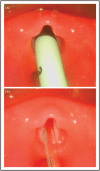Less invasive surfactant administration: best practices and unanswered questions
- PMID: 32068592
- PMCID: PMC7077956
- DOI: 10.1097/MOP.0000000000000878
Less invasive surfactant administration: best practices and unanswered questions
Abstract
Purpose of review: The purpose of this review is to describe current concepts in the field of Less Invasive Surfactant Administration (LISA). The use of continuous positive airway pressure (CPAP) has become standard for the treatment of premature infants with respiratory problems throughout the world. However, if CPAP fails, technologies like LISA are needed that can combine surfactant delivery and spontaneous breathing with the support of noninvasive modes of ventilation.
Recent findings: LISA with thin catheters has been in use in Germany for more than 15 years. In the last 5 years, there was substantial interest in this method around the world. Randomized studies and recent metaanalyses indicate that the LISA technique helps to avoid mechanical ventilation especially in emerging respiratory distress syndrome (RDS). LISA is also associated with improved outcomes of preterm infants, specifically in the prevention of bronchopulmonary dysplasia (BPD) and intracranial hemorrhage (ICH). By now, a variety of different LISA catheters, devices and techniques have been described. However, most of the technologies are still connected with the unpleasant experience of laryngoscopy for the affected infants, so that the search for even less invasive techniques, for example, surfactant application by nebulization, goes on.
Summary: Maintenance of spontaneous breathing with support by the LISA technique holds big promise in the care of preterm infants. Patient comfort and lower complication rates are strong arguments to further investigate and promote the LISA approach. Open questions include exact indications for different patient groups, the usefulness of devices/catheters that have recently been built for the LISA technique and -- perhaps most urgently -- the issue of analgesia/sedation during the procedure. Studies on long-term outcome after LISA are under way.
Figures



References
-
- More K, Sakhuja P, Shah PS. Minimally invasive surfactant administration in preterm infants: a meta-narrative review. JAMA Pediatr 2014; 168:901–908. - PubMed
-
- Herting E. Less Invasive Surfactant Administration (LISA) - ways to deliver surfactant in spontaneously breathing infants. Early Hum Dev 2013; 89:875–880. - PubMed
-
- Verder H, Agertoft L, Albertsen P, et al. Surfactant treatment of newborn infants with respiratory distress syndrome primarily treated with nasal continuous positive air pressure. A pilot study. Ugeskr Laeger 1992; 154:2136–2139. - PubMed
-
- Verder H, Robertson B, Greisen G, et al. Surfactant therapy and nasal continuous positive airway pressure for newborns with respiratory distress syndrome. Danish-Swedish Multicenter Study Group. N Engl J Med 1994; 331:1051–1055. - PubMed
-
- Dargaville PA, Gerber A, Johansson S, et al. Australian and New Zealand Neonatal Network. Incidence and outcome of CPAP failure in preterm infants. Pediatrics 2016; 138: pii: e20153985. - PubMed
Publication types
MeSH terms
Substances
LinkOut - more resources
Full Text Sources
Other Literature Sources
Research Materials

